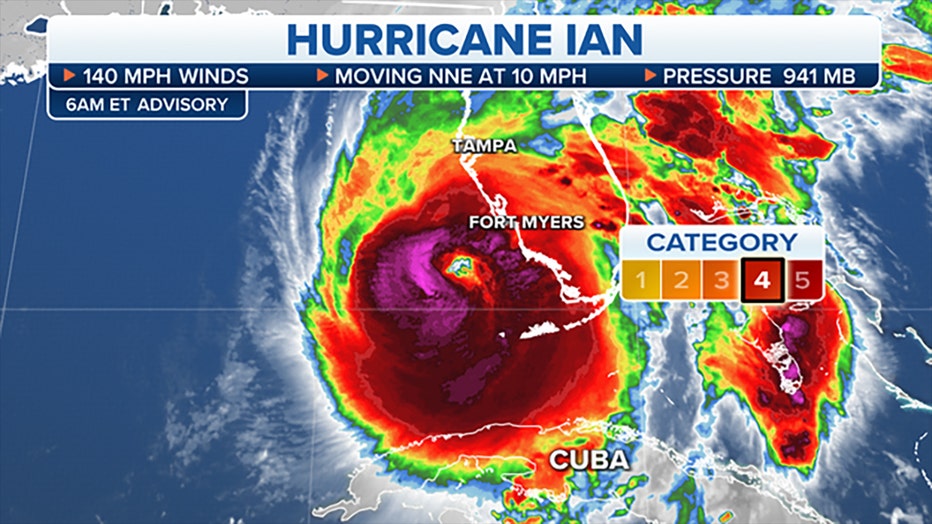Tracking Hurricane Ian: Category 4 storm hits Florida with 155 mph winds
ST. PETERSBURG, Fla. - Hurricane Ian intensified into an extremely dangerous Category 4 storm as it approached and then hit Florida on Wednesday. The powerful storm made landfall on an already soaked Sanibel Island and Captiva Island in southwest Florida.
The National Hurricane Center said that maximum sustained winds had increased to 155 mph. Those speeds were recorded by a Hurricane Hunter aircraft that flew into the storm. Those wind speeds are just below Category 5 status. And the storm was "rapidly intensifying," according to weather officials.
Tropical storm force winds and rain are hitting the state’s heavily populated Gulf Coast, with the Naples to Sarasota region at "highest risk" of a devastating storm surge.
"This is going to be a nasty, nasty day, two days," Florida Gov. Ron DeSantis said, stressing that people in Ian’s path along the coast should rush to the safest possible shelter and stay there.
The hurricane could push as much as 12 feet (3.6 meters) of ocean water ashore in Florida, the U.S. National Hurricane Center in Miami said, urging people to evacuate the danger zone if they still can. More than 2.5 million people were under mandatory evacuation orders, but by law no one could be forced to flee.
Off the coast on Sanibel Island near Fort Myers, swirling water covered residential streets and was halfway up mailbox posts by mid-morning. Seawater rushed out of Tampa Bay, leaving parts of the muddy bottom exposed, and waves crashed over the end of a wooden pier at Naples.

NYC Weather Forecast and Hurricane Update
Nick Gregory has an update on the progress of Hurricane Ian and the weather forecast for the New York City area.
Florida residents rushed ahead of the impact to board up their homes, stash precious belongings on upper floors and flee.
"You can’t do anything about natural disasters," said Vinod Nair, who drove inland from the Tampa area Tuesday with his wife, son, dog and two kittens seeking a hotel in the tourist district of Orlando. "We live in a high risk zone, so we thought it best to evacuate."
Ian’s forward movement slowed over the Gulf, enabling the hurricane to grow wider and stronger. A hurricane warning covered roughly 220 miles (350 kilometers) of the state. Tampa and St. Petersburg were included, and could potentially get their first direct hit by a major hurricane since 1921.
Gil Gonzalez wasn't taking any chances. He boarded the windows of his Tampa home with plywood and laid down sandbags to guard against any flooding. He and his wife packed their car with bottled water, flashlights, battery packs for their cellphones and a camp stove before evacuating.
"All the prized possessions, we’ve put them upstairs in a friend’s house," Gonzalez said.

Airports in Tampa, St. Petersburg and Key West closed. Disney World theme parks and Sea World in Orlando all closed ahead of the storm.
A couple from England on vacation in Tampa found themselves faced with riding out the storm at a shelter. Glyn and Christine Williams of London were told to leave their hotel near the beach when evacuations were ordered. Because the airport shut down, they could get no flight home.
"Unfortunately, all the hotels are full or closed, so it looks as though we’re going to be in one of the shelters," Christine Williams said.
Her husband insisted all would be fine. "You know, you got to go with the flow," Glyn Williams said. "So we’re quite happy doing what we’re doing."
The precise location of landfall was still uncertain, but with Ian's tropical storm-force winds extending 175 miles (280 kilometers) from its center, damage was expected across a wide area of Florida. Flash floods were possible across the whole state, and portions of its east coast faced a potential storm surge threat as Ian’s bands approach the Atlantic Ocean. Warnings also were issued for isolated tornadoes.
Florida Power and Light warned those in Ian's path to brace for days without electricity. As a precaution, hundreds of residents were being evacuated from several nursing homes in the Tampa area, where hospitals also were moving some patients.
Parts of Georgia and South Carolina also could see flooding rains and some coastal surge into Saturday. Georgia Gov. Brian Kemp preemptively declared an emergency, ordering 500 National Guard troops onto standby to respond as needed.
Before turning toward Florida, Ian struck Cuba’s Pinar del Rio province with sustained winds of 125 mph (205 kph) and causing destruction in the island nation's world-famous tobacco belt. No deaths were reported.
Local government station TelePinar reported heavy damage at the main hospital in Pinar del Rio city, tweeting photos of collapsed ceilings, widely flung debris and toppled trees. Some people left the stricken area on foot, carrying their children, while buses tried to evacuated others through waterlogged streets. Others opted to stay at their damaged houses.
"It was horrible," said Yusimi Palacios, a resident of Pinar del Rio inside her damaged house. "But here we are alive, and I only ask the Cuban revolution to help me with the roof and the mattress."
With The Associated Press.

